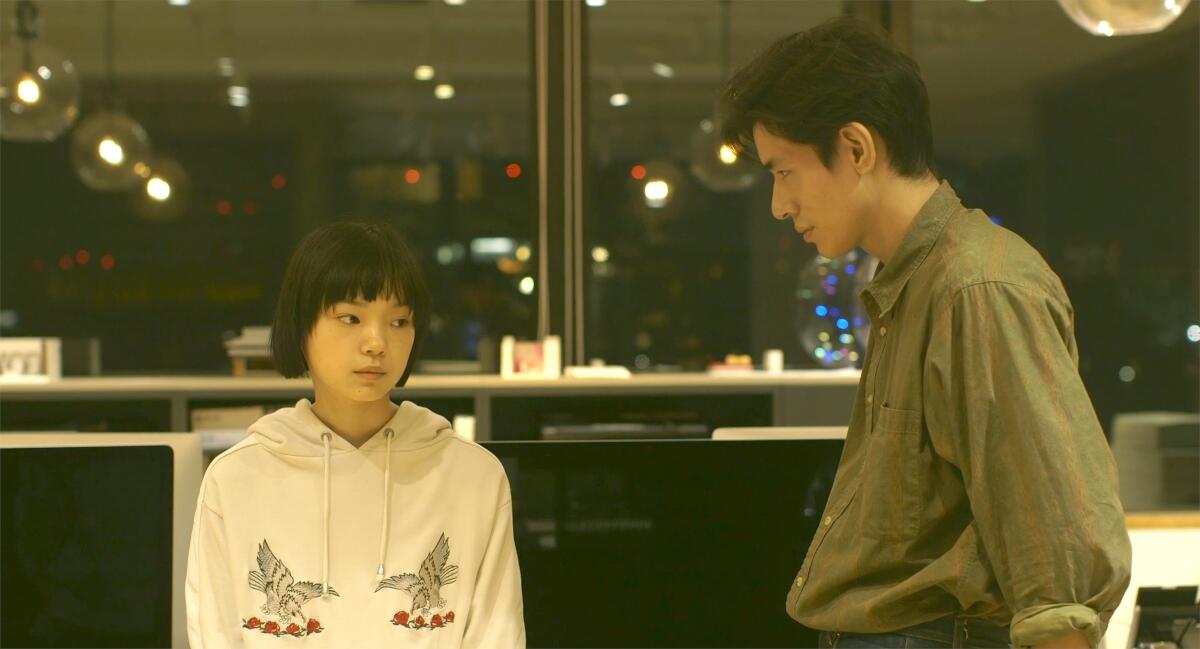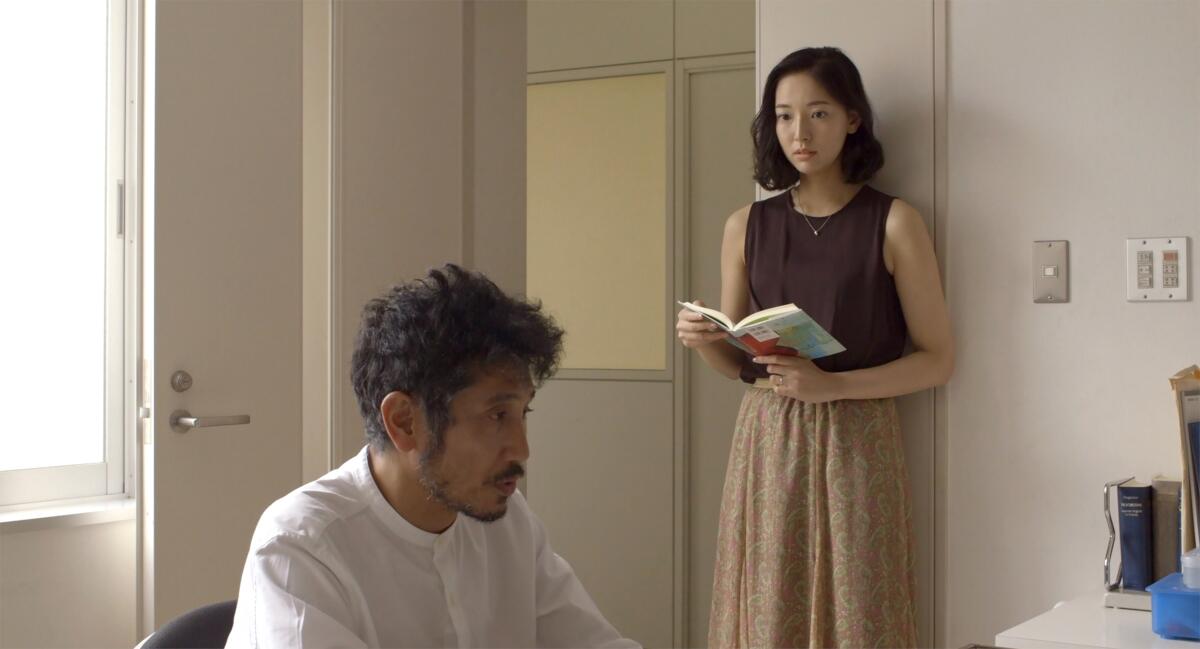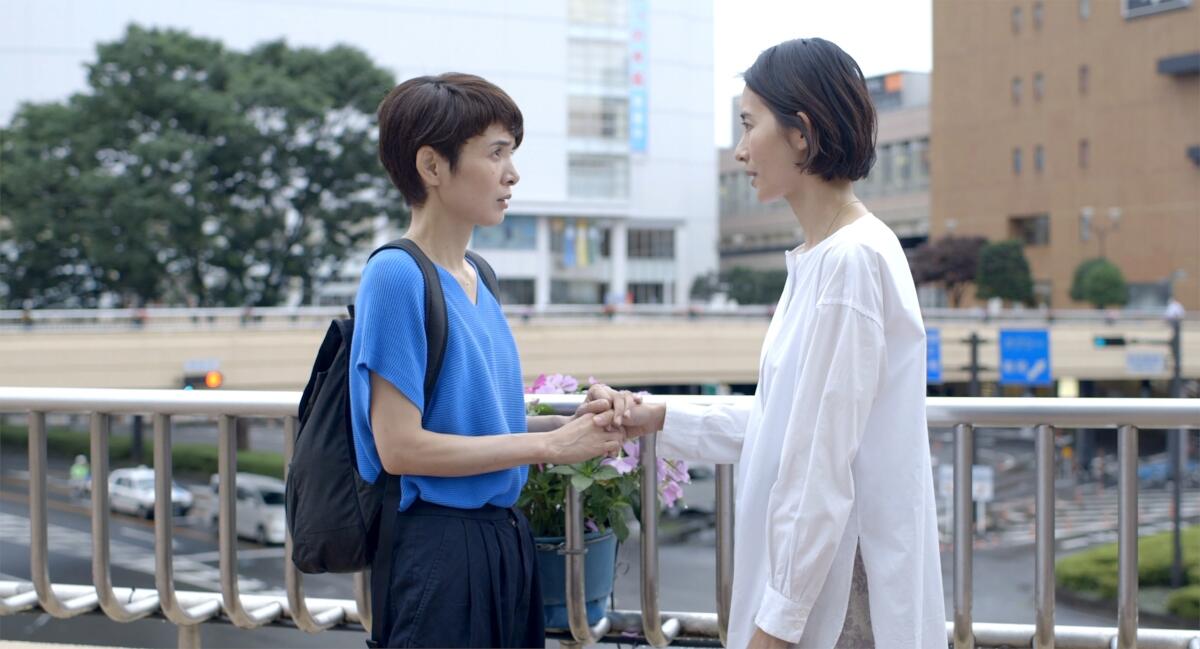Review: The marvelous Japanese trilogy ‘Wheel of Fortune and Fantasy’ is well worth a spin

- Share via
The Times is committed to reviewing theatrical film releases during the COVID-19 pandemic. Because moviegoing carries risks during this time, we remind readers to follow health and safety guidelines as outlined by the Centers for Disease Control and Prevention and local health officials.
Mysterious doublings tend to occur and recur in the work of the brilliant Japanese writer-director Ryûsuke Hamaguchi, one of the most exciting filmmaking talents to emerge in recent years. His work, which came to international prominence with his epically intimate ensemble drama “Happy Hour” (2015), has shown an abiding fascination with the nature of chance, the way coincidences thread themselves through the (seeming) banality of the everyday. That idea reached a zenith of sorts in his 2018 feature, “Asako I & II,” a deftly twice-told love story that abounded in doppelgängers real and imagined.
And so there’s something curiously fitting about the fact that, through the vagaries of fate (and the production upheavals of the COVID-19 pandemic), Hamaguchi has emerged with not one but two remarkable new features this year. I’ll have more to say about “Drive My Car,” his nearly three-hour elaboration of a Haruki Murakami short story, when it opens in theaters in November. The one under review this week, “Wheel of Fortune and Fantasy,” provides a contrasting yet oddly complementary experiment with the short-story form. A poignant, sometimes piercing triptych of tales, each one predicated on chance encounters and romantic possibilities (the original Japanese title translates as “Coincidence and Imagination”), it finds Hamaguchi in playful, beguiling and quietly affecting form.

“Quietly” may not be strictly accurate. Arriving several months after its prize-winning Berlin International Film Festival premiere, “Wheel of Fortune and Fantasy,” like many of Hamaguchi’s movies, is propelled by the ceaseless, almost musical flow of its dialogue. Each roughly 40-minute episode takes the form of a primarily two-character exchange, precisely shot (by Yukiko Iioka) and built around volleys of verbiage that gather casual yet beautifully modulated swells of emotion. This feeling of spontaneity is in fact achieved through an intensely rigorous rehearsal process designed to drain any trace of false affect or emotion from the actors’ delivery — a process that brings to mind the similarly repetitive working methods of the late French master Robert Bresson, but whose on-screen effect is very much Hamaguchi’s own.
In the first story, “Magic (or Something Less Assuring),” this emotional restraint produces a startling degree of tension. We’re in the back seat of a taxi with young Meiko (Kotone Furukawa), who listens intently as her friend Tsugumi (Hyunri) speaks of a recent “magical” first date. Outwardly excited for her friend, Meiko betrays little hint of her nagging suspicions, which are confirmed once we meet the handsome magician in question, Kazuaki (Ayumu Nakajima). The unhappy romantic happenstance at the heart of this yarn calls into question the shifting nature of protagonists and antagonists, and the rigid assumptions we often make about who’s who. “If there’s anyone evil in this story, it’s you,” someone tells Meiko at one point. But as her alternately thoughtful and impulsive actions remind us, terms like good and evil are much too reductive to ascribe to behavior so messily, recognizably human.
“Magic (or Something Less Assuring)” hinges, in part, on a certain confusion about names, a mistaken-identity theme that it shares with the other two stories. Up next is “Door Wide Open,” which is dominated by an extraordinary encounter between a renowned professor and author, Segawa (Kiyohiko Shibukawa), and a former student, Nao (Katsuki Mori), who visits his office and asks him to autograph her copy of his most recent novel. The possibility of impropriety rears its head when Nao begins to read aloud from an erotically charged passage in the book, though what these two equally lonely souls need from each other turns out to be something more mysterious and complicated than a sexual encounter. The nature of that need shifts beautifully and almost imperceptibly over their conversation, en route to an O. Henry-like sting in the tail.

Unlike its predecessors, the third and most affecting story, “Once Again,” focuses on two women. It also takes place in a world that’s been taken offline after a wave of debilitating computer viruses — a modest science-fiction conceit that enables this story’s exceedingly strange encounter. One day, two women (played by Aoba Kawai and Fusako Urabe) recognize each other on passing escalators — an effortless visual metaphor for this movie’s many stray encounters — and spend the afternoon together, reminiscing about their times in high school. But the more they talk, the less they seem to understand, nearly losing each other and perhaps even themselves in a flood of memories, regrets and forbidden but not forgotten desires.
If that sounds hazy, it isn’t. Hamaguchi has plotted this story with great precision and ingenuity, and that precision miraculously deepens, rather than cheapens, the lost history that passes between these two women. The unforgettable closing image contains emotional multitudes, and it throws the meaning of all three stories into subtly clarifying relief: The past may be irretrievable, but the present is still a gift.
‘Wheel of Fortune and Fantasy’
In Japanese with English subtitles
Not rated
Running time: 2 hours, 1 minute
Playing: Starts Oct. 15 at the Landmark, West Los Angeles
More to Read
Only good movies
Get the Indie Focus newsletter, Mark Olsen's weekly guide to the world of cinema.
You may occasionally receive promotional content from the Los Angeles Times.











